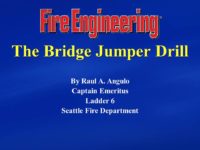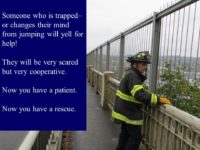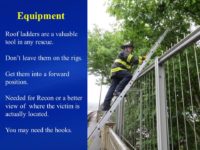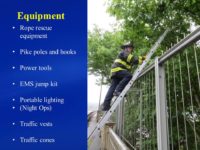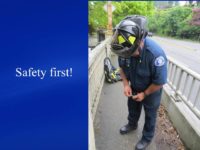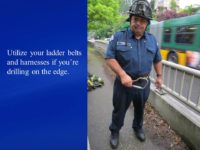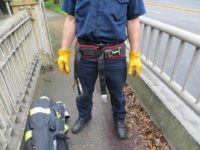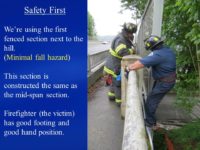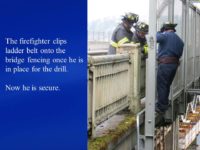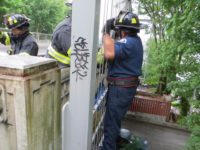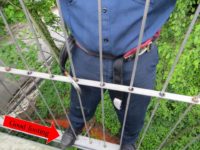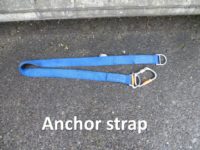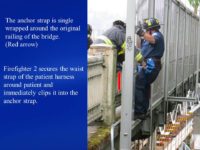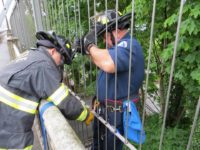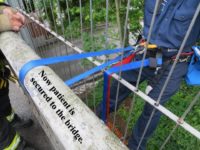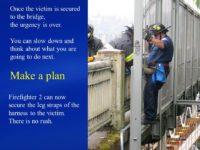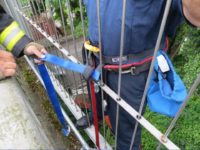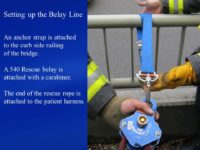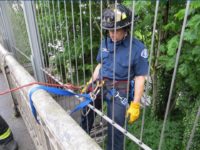By Raul Angulo
“Rescue Response, Engine 9, Ladder 6, Rescue 1, Medic 18, and Battalion 4. Aurora Bridge – Jumper on the bridge.”
This is a dispatch I heard throughout my career as a lieutenant on Engine 9 and again as captain of Ladder 6. The Aurora Bridge, formally known as the George Washington Memorial Bridge, is a cantilever and truss bridge that opened in Seattle, Washington on February 22, 1932. It is 167 feet high, spans 475 feet across the water, and is 70 feet wide. The total length of the bridge is 2,945 feet. Like many landmark bridges in major cities, it has been the site of many high-profile incidents.
On November 27, 1988, the Metro Bus shooting–which killed three people–happened on the Aurora Bridge. After the bus driver was shot twice, the shooter turned the gun on himself. With the driver dead, the bus veered off the bridge and fell 50 feet, landing on the roof of an apartment complex below the bridge. Thirty-six people were also injured in this spectacular crash.
The Aurora Bridge was also the site for another spectacular crash that occurred on September 24, 2015 when the Duck, an amphibious vehicle tourist attraction, lost control and crashed into the side of charter bus, killing five exchange students who were inside the bus. There were no fatalities of tourists riding the Duck.
Another harsh reality of life is suicide. It’s been around since the Bible but it’s never easy to accept. The Aurora Bridge is in the top 10 suicide structures in the world and is the second most “popular” bridge for committing suicide in the United States (The Golden Gate Bridge in San Francisco, California is #1). There have been more than230 suicides on the Aurora Bridge, which means on average, there’s one jumper approximately every three months. I’ve personally been on 10 jumper incidents that I can immediately recall. Bottom line, if you have a structure in your city that has a history as a suicide venue, you better plan for it because it’s going to happen again. It’s just life.
What’s Your Department’s Policy?
Many cities have policies for these type of incidents. Sometimes the fire department is the lead agency; most times the police department is the lead agency. The police get specialized human and psychological behavior training to handle hostage negotiations and suicide prevention. It is unlikely that fire departments receive this type of training. The police usually have an officer or a team qualified to respond and handle (talk down) bridge jumpers. The fire department may also require the technical rescue team to be the lead company in charge of the fire department’s rescue responsibilities in this multi-agency response. So, know your department’s policy and procedures for suicide attempts of this nature and follow them, however no policy can cover every situation.
What are you going to do if the police are tied up in another serious incident across town and it could be considerable time before a qualified negotiating team can be assembled? Or what if the technical rescue team is out of service on another call? If you’re on a ladder company and you could find yourself being first-in on a bridge jumper, you have to have a contingency plan. You have a duty to act. The public expects it, especially with all the rescue equipment that is carried on a truck company. We have at times over-regulated many of the tasks that used to be common practice for a regular fire company and have made these tasks “specialized,” to be performed only by those who have received certified training. Don’t get caught in the oxymoronic predicament of “You know, we would have been able to save him before we were trained.” Have a plan. This is the plan my crew and I came up with.
The Drill
First, Remember this!
If you have someone who wants to jump or is threatening to jump – you do not have a patient or a viable victim. They do not want to be rescued. Therefore, this is NOT a rescue. This is a police incident. Secure the area and WAIT for the police.
If you’re not sure if they are suicidal, WAIT for the police.
Don’t become part of the problem or risk endangering your crew for someone who has a death wish.
Usually someone who is trapped or changes their mind from jumping will yell for help. They will be very scared, but they will be very cooperative.
Now you have a patient or a viable victim.
Now you have a rescue.
RELATED
RESPONDING TO JUMPER INCIDENTS
RESCUERS SAVE JUMPER FROM TOWER CRANE
JUMPER ON POWER LINE
“Suicide in Progress”: Response Strategies
Equipment
There’s no specific list, but talk with your crew on what they think is important to bring on the first go and what they can actually carry. Then prepare a list of equipment you’ll need to request from other incoming units.
Roof ladders are a valuable tool in any rescue, but especially for bridges. Don’t leave them on the rigs. Get ladders into a forward position, ready to deploy. That may be the only tool you need. You may also need the hooks. Here’s a list of other equipment to consider:
- Rope rescue equipment
- Pike poles and roof hooks
- Power tools
- EMS jump kits
- Portable lighting (night ops)
- Traffic vests
- Traffic cones
Consider spotting the apparatus to block your immediate area from oncoming traffic.
Safety First: The Set Up
Perform a risk/benefit analysis for the training objective. Use common sense and select a reasonable evolution without taking unnecessary risks. It’s not worth getting a crew member hurt while training; but you need to train for this.
Use ladder belts and rescue harnesses if you’re drilling on the edge.
Many bridges have protective metal fencing or barriers to discourage people from trying to climb on the outside of the bridge, but often it is still easy for a determined person to get around them. Drill on the section closest to the end of the bridge. The first section is usually constructed the same way the mid-span section is constructed. This reduces the fall hazard to the lowest risk possible for the firefighters. Make sure the section has good footing and places to hold on to for a firm grip.
One of the crew members need to play the victim. Once the firefighter is in place, secure the ladder belt to the bridge. Now the firefighter is secured to the bridge and you’re ready to start the actual evolution.
The Evolution
While working from the bridge deck, Firefighter 1 reaches through the railing to quickly grab hold of the victim by any means possible.
Firefighter 2 grabs an anchor strap and wraps it around the railing. Then Firefighter 2 reaches through the railing and applies the patient harness waist strap to the victim and immediately clips it on to the anchor strap using a carabiner. Firefighter 1 can use one hand to assist in holding the patient harness against the waist while Firefighter 2 secures it. Now the victim is secured to the bridge.
Once the victim is secured to the bridge, the urgency is over. Take the time to properly secure the leg straps of the patient harness to the victim. Now you can slow down and think about what you’re going to do next. Get together and make a plan.
In our scenario, we decided to throw another anchor strap onto the bridge railing and set up a belay system using a 540 device. The rope ran through the 540 and was attached to the patient harness with a carabiner. Now this patient is totally secured with a backup system.
Rescuing the Victim
If the victim is to be lowered to the ground, or to a waiting rescue boat on the water below the bridge, a main line would have to be rigged of sufficient length to reach the water’s surface below in addition to the belay line. A 300-foot rescue rope is sufficient for our bridge since it is only 167 feet high.
In our scenario, we chose to make a door through the metal fence and pull the victim onto the bridge deck. A battery-powered recip saw with a metal cutting blade will work just fine. How do I know? Because Ladder 6 ended up having this exact scenario in real life on the Aurora Bridge. The rescue was a success. Quick, safe, and simple. Keep it simple. That’s about all there is to it.
Drills You Won’t Find in the Books: The Steel-Toe Boot Drill
Tiller Tape, Stripes, Markers, and Other Clever Uses for Tape
Your Ability to Call a Mayday Depends on How You Wear Your Radio
 RAUL A. ANGULO is Captain Emeritus of Ladder Co. 6 and retired from the Seattle (WA) Fire Department with over 35 years of dedicated service. He is an international author and instructor and serves on the advisory board for Fire Apparatus and Emergency Equipment magazine.
RAUL A. ANGULO is Captain Emeritus of Ladder Co. 6 and retired from the Seattle (WA) Fire Department with over 35 years of dedicated service. He is an international author and instructor and serves on the advisory board for Fire Apparatus and Emergency Equipment magazine.
